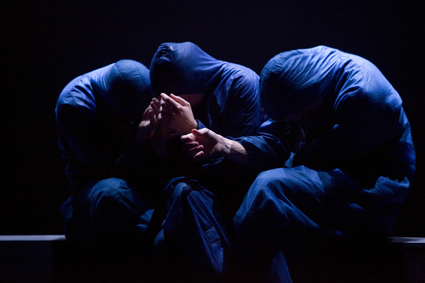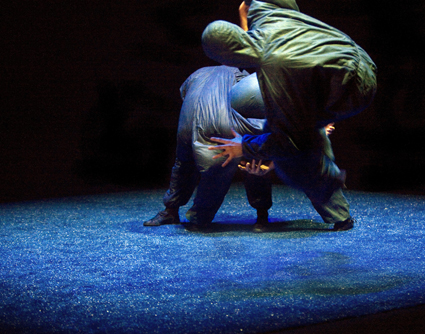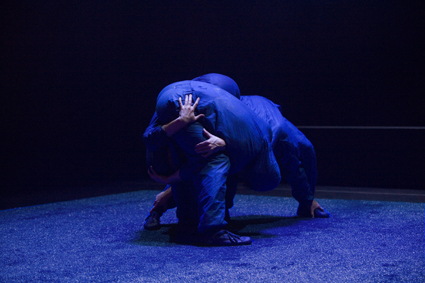dance massive 2013
March 27 2013
dance: installed, immersed, hybridised
keith gallasch: dance massive 2013
quotidian moves, gangnam-style
philipa rothfield: ben speth, wetubelive
dance massive 2013
sounds to dance to, with, against
gail priest: sound design in dance massive 2013
March 26 2013
the life in the work
philipa rothfield: tracie mitchell, dance screen retrospective
youtubing live
varia karipoff: ben speth, wetubelive
dance massive 2013
March 24 2013
dance & disorientation
keith gallasch: tim darbyshire, more or less concrete
more or less monstrous
jana perkovic: atlanta eke, monster body
realtime tv: tim darbyshire, more of less concrete, dance massive 2013
March 22 2013
ritual entwining
philipa rothfield: soo yeun you, [gu:t] [work-in-progress]
strange affliction: dance massive & transcendence
keith gallasch: jo lloyd, future perfect
March 21 2013
a not so private hearing
carl nilsson-polias: tim darbyshire, more or less concrete
realtime tv: antony hamilton, black projects 1& 2, dance massive 2013
something ends, something begins
virginia baxter: dance exchange, dance for the time being - southern exposure
dance massive 2013
the perfection of submission
varia karipoff: jo lloyd, future perfect
March 20 2013
inner fury, seductive skill
philipa rothfield: anouk van dijk, chunky move, 247 days
March 20 2013
old tropes & the new disconnect
carl nilsson-polias: lucy guerin inc & belvoir, conversation piece
March 19 2013
now, then, now
keith gallasch: sandra parker, the recording
realtime tv: anouk van dijk, 247 days, chunky move, dance massive 2013
dance massive 2013
March 18 2013
creating an affective community
jana perkovic: matthew day, intermission
fun and the damage done
keith gallasch: larissa mcgowan, skeleton
more than smoke and mirrors
virginia baxter: ashley dyer, life support
realtime tv: lee serle, p.o.v., dance massive 2013
March 17 2013
realtime tv: dalisa pigram, gudirr gudirr, dance massive 2013
the body un-mirrored
jana perkovic: anouk van dijk, chunky move, 247 days
the origins of feeling
philipa rothfield: sandra parker, the recording
March 16 2013
realtime tv: stephanie lake, dual, dance massive 2013
dance massive 2013
March 15 2013
a dance for dark times
virginia baxter: dalisa pigram, gudirr gudirr
brittle bones & internal electricity
carl nilsson-polias: larissa mcgowan, skeleton
in the thick of it
philipa rothfield: lee serle, p.o.v.
March 15 2013
inside the audience
jana perkovic: lee serle, p.o.v
the poetry of pain
keith gallasch: stephanie lake, dual
dance massive 2013
when two become one
varia karipoff: stephanie lake, dual
March 14 2013
blacker than black
keith gallasch: antony hamilton, black projects 1 & 2
life in a puff
carl nilsson-polias: ashley dyer, life support
March 13 2013
dark symmetries
carl nilsson-polias: antony hamilton, black projects 1 & 2
lines of flight
philipa rothfield: dalisa pigram, gudirr gudirr
dance massive 2013
suggestive formalism
jana perkovic: natalie abbott, physical fractals
unsettling the audience
varia karipoff: natalie abbott, physical fractals
February 22 2013
an intense manifestation of dance
philipa rothfield: dance massive 2013, melbourne
dance massive 2013: from the archive
lucy guerin inc, conversation piece; antony hamilton, black project; atlanta eke, this monster body; matthew day, intermission; jo lloyd, future perfect; tim darbyshire, more or less concrete; natalie abbot, physical fractals; ben speth, wetubelive
 |
More or Less Concrete, Tim Darbyshire
photo Ponch Hawkes |
IN LIVE ART, CONTEMPORARY PERFORMANCE, DANCE, CINEMA AND DIGITAL ART THERE’S BEEN AN INCREASING FOCUS ON ENGAGING AUDIENCES WITH IMMERSIVE EXPERIENCES THAT UNSETTLE NORMAL PERCEPTUAL PROCESSES.
In performance, approaches range from one-on-one encounters and sensory deprivation (eg total blackout or blindfolding in order to enhance hearing and touch), to various digital strategies, including the use of cinematic techniques and surround sound.
In Natalie Abbott’s
Physical Fractals and, moreso, Antony Hamilton’s
Black Project 2 there are times when you are not sure what you are seeing. No digital trickery is involved. In
Physical Fractals it’s the rapid movement of two bodies in radically diminishing light such that limbs become barely visible brush strokes in the dark (oddly, not unlike the tracery caught by digital cameras). In
Black Project 2, a pulsing organism turns out to be a cluster of human bodies that mutates such that its components, six dancers, rarely figure as individual humans. Matthew Day’s
Intermission also plays with our perceptual attentiveness as we empathically attune to the fast “wave vibrations” that so very slowly propel him (see
interview).
In Tim Darbyshire’s thoroughly immersive and aptly titled More or Less Concrete the visual and aural senses are confounded, often at the same time. Visually, this is accomplished by Darbyshire’s intensely slow-moving sculptural choreography and initially very low levels of light (further muted by a forestage scrim). Three bodies are interlocked in such a way that it’s hard to discern where each begins and ends. Eventually, as our eyes keep adjusting, one body slowly breaks off. With a crash the structure collapses—a rare moment of shock in More or Less Concrete. That first body rolls forward, reshaping, and is then followed by the others. Their slow time has by now become ours as we slip into a contemplative state.
 |
More or Less Concrete, Tim Darbyshire
photo Ponch Hawkes |
At the same time, each of us in the audience wearing the provided headphones has been overhearing a distant, muted conversation without grasping its content, as if the real world is slipping away from us. There are noises too, rustlings, breathing, eventually revealed to be coming from the miked performers. We hear what could be soft rain and wind. It becomes more intense, almost stormy, oceanic even, somehow resonant with the enveloping blue light. (I learn later from Darbyshire that nearly all this sound comes direct from the stage, treated digitally by sound designer Jem Savage in a show which also credits a dramaturg/sound theorist, Thembi Soddell.)
The three bodies emit gasps, extreme exhalations and coughs while hands slap and brush the floor, creating an odd musicality. Darbyshire’s three dancers (he’s one of them) continue to appear alien, their full human form denied us as, backs to us, they turn upside down, legs and feet away from us, unseen. Bottoms up, they appear octopus-like—bulbous shapes with arms spread out flat to the floor like tentacles, hands thumping and swishing. When the trio suddenly swing their legs over their torsos to hit the floor with their feet, their heads remain pulled back, out of sight, creating a new breed: headless humans.
In the ensuing action, the performers move inexorably, if as slowly as ever, towards us. More palpably human and in now intensely blue light they raise a low wall, crawl over it, scuffing across a sparkling blue terrain and generating something like wind moving across a grassy plain. In a line they swivel back and forward, as if ascertaining which direction to take before committing to keep moving forward. We glimpse their faces.
Finally they stand before us, heads moving as if gauging their whereabouts; but their eyes are closed, suggesting beings who have either not evolved sight or who, living in darkness, have lost it. One turns away and moves slowly back into the dark. The other two lean back to back, knees bent low, a new creature, following the first into invisibility.
 |
More or Less Concrete, Tim Darbyshire
photo Ponch Hawkes |
As Darbyshire himself suggests in his program note, More or Less Concrete is rich in connotations. Like Gideon Obarzanek’s Glow or his Mortal Engine, or Antony Hamilton’s Black Project 2, there’s an evocation of non-human, organic life without making it literal: in the end it’s about the ways human bodies move and connect formally and quite abstractly expressed through dance. Darbyshire writes in his program note, “The bodies are abstracted as they transform between human, animal, monster, machine and ‘other.’ The choreography oscillates and suspends between recognisable ‘concrete’ realities and ambiguous or surrealistic states.”
Darbyshire describes More or Less Concrete as “an analytical performance work, centred on introverted and contained bodies that observe and listen.” These words could equally apply to the audience as much as to the personae in More or Less Concrete. It’s a thought that occupies Darbyshire, as revealed in his
realtime tv interview.
In contrast to the fervid energy expended in the movement and sound in most works in Dance Massive 2013, More or Less Concrete’s tautly focused scenario extends and suspends our sense of time with dextrously slow movement, contortion and balance, finely tuned lighting and subtle performer-driven soundscapes. Not at all dancerly in a conventional sense, but demandingly drawing on the capacities of trained dancers, More or Less Concrete is an exemplar of lo-tech sensory immersion with which Tim Darbyshire challenges us to reassess our sensory grasp of the world.
Dance Massive: Arts House & Tim Darbyshire: More or Less Concrete, choreographer Tim Darbyshire, performers: Sophia Cowen, Tim Darbyshire, Josh Mu, sound Design Jem Savage, lighting Ben (Bosco) Shaw, Bluebottle, dramaturge, sound theorist Thembi Soddell, costumes Rebecca Agnew; Arts House, North Melbourne Town Hall, March 20-24; http://dancemassive.com.au
See the realtime tv interview with Tim Darbyshire and Carl Nilsson-Polias' review.
RealTime issue #114 April-May 2013 pg. 29
© Keith Gallasch; for permission to reproduce apply to [email protected]
Back to top











 back
back